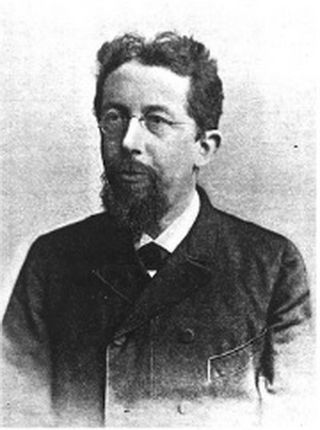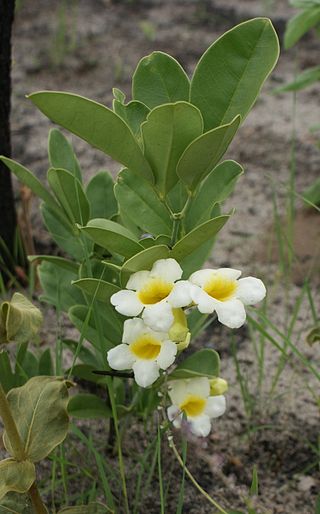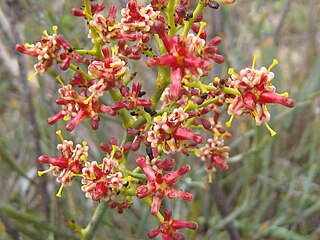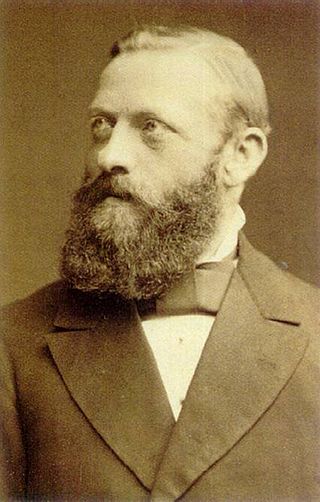
Carl Friedrich Philipp von Martius was a German botanist and explorer. Between 1817 and 1820, he travelled 10,000 km through Brazil while collecting botanical specimens. His most important work was a comprehensive flora of Brazil, Flora Brasiliensis, which he initiated in 1840 and was completed posthumously in 1906.

Stephan Friedrich Ladislaus Endlicher, also known as Endlicher István László, was an Austrian botanist, numismatist and Sinologist. He was a director of the Botanical Garden of Vienna.

Karl Moritz Schumann was a German botanist.

August Wilhelm Eichler, also known under his Latinized name, Augustus Guilielmus Eichler, was a German botanist who developed a new system of classification of plants to reflect the concept of evolution. His author abbreviation in botany is Eichler.

Senecio pulcher is an ornamental plant native to the wet valleys & slopes and flooded rocky habitats in Argentina, Brazil, and Uruguay. Cited in Flora Brasiliensis by Carl Friedrich Philipp von Martius. After dusty miller, S. pulcher is perhaps one of the most popular species of the genus for horticulture along with German ivy and purple ragwort or it was in 1917.
Astronium fraxinifolium is a timber tree, which is native to Amazon Rainforest, Atlantic Forest, Caatinga, and Cerrado vegetation in Brazil. Common names include kingwood, locustwood, tigerwood, and zebrawood. It is known in Portuguese as Gonçalo-alves. This plant is cited in Flora Brasiliensis by Carl Friedrich Philipp von Martius. It is also used to make hardwood such as tigerwood.

Anemopaegma glaucum is a plant native to Caatinga and Cerrado vegetation in Brazil. This plant is cited in Flora Brasiliensis by Carl Friedrich Philipp von Martius.

Historia naturalis palmarum: opus tripartitum is a highly illustrated, three-volume botanical book of palms (Arecaceae) by German botanist Carl Friedrich Philipp von Martius. The work is in Latin and was published in imperial folio format in Leipzig (Lipsiae) by T.O. Weigel, volume one in 1823 and the final volume in 1850. It includes more than 550 pages of text and 240 chromolithographs, including views of habitats and botanical dissections.

Arthrocereus glaziovii is a species of plant in the family Cactaceae. It is endemic to Brazil. Its natural habitat is rocky areas. It is threatened by habitat loss.

Arthrocereus melanurus is a species of plant in the family Cactaceae. It is endemic to Brazil. Its natural habitats are dry savanna and rocky areas. It is threatened largely by habitat loss.

Stirlingia, commonly known as blueboy, is a genus of 7 species in the family Proteaceae, all of which are endemic to Western Australia.

"A Sketch of the Vegetation of the Swan River Colony", also known by its standard botanical abbreviation Sketch Veg. Swan R., is an 1839 article by John Lindley on the flora of the Swan River Colony. Nearly 300 new species were published in it, many of which are still current.

Ignatz Urban was a German botanist. He is known for his contributions to the flora of the Caribbean and Brazil, and for his work as curator of the Berlin Botanical Garden. Born the son of a brewer, Urban showed an interest in botany as an undergraduate. He pursued further study at the University of Bonn and later at the University of Berlin where he gained a doctorate in 1873. Urban was appointed by A. W. Eichler to run the Berlin Botanical Garden and supervised its move to Dahlem. He also worked as Eichler's assistant on the Flora Brasiliensis, later succeeding him as editor. In 1884 Urban began working with Leopold Krug on his Puerto Rican collections, a collaboration would later produce the nine-volume Symbolae Antillanae, one of his most important contributions, and his 30-part Sertum Antillanum. Urban's herbarium, estimated to include 80,000 or more sheets, was destroyed when the Berlin Herbarium was bombed in 1943, during the Second World War.

Zizaniopsis is a genus of plants in the grass family, Poaceae, native to North and South America.
Telmatophila is a genus of flowering plants in the tribe Vernonieae within the family Asteraceae.

Eduard Fenzl was an Austrian botanist.
Adalbert Carl Friedrich Hellwig Conrad Schnizlein was a German botanist and pharmacist. He is largely remembered for his work in the fields of plant taxonomy and phytogeography.

Joseph August Schenk was an Austrian-born, German botanist and paleobotanist.
Eremitis is a genus of bamboo plants in the grass family, that is endemic to Brazil.
Plantae preissianae sive enumeratio plantarum quas in australasia occidentali et meridionali-occidentali annis 1838-1841 collegit Ludovicus Preiss, more commonly known as Plantae preissianae, is a book written by Johann Georg Christian Lehmann and Ludwig Preiss.















